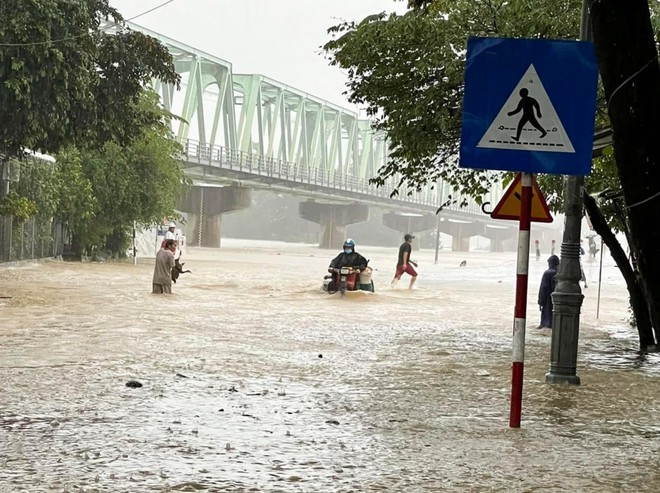Late night on November 30, heavy rain continued to pour down on the area from Quang Nam to Ninh Thuan and the Central Highlands. From 7:00 a.m. on November 30 to the early morning of December 1, the amount of rain recorded in many places exceeded 150 mm, in some places over 200 mm. Rain concentrated in Quang Ngai, Phu Yen, Khanh Hoa, Dak Lak, Gia Lai and Lam Dong.
At 10:30 p.m. on November 30, flood water continued to pour in, causing flooding in many areas in Nha Trang City, Khanh Hoa province. Heavy rain and the impact from the discharge of hydroelectric reservoirs caused many houses in Khanh Hoa to flood. Local people stay up all night to watch the flood.
According to the National Center for Hydro-Meteorological Forecasting, at dawn on December 1, floods on the Ba River (Phu Yen) and rivers in Khanh Hoa peaked, then slowed down. In the next 6-12 hours, floods in rivers in Quang Ngai will drop to alarming levels 1 and 2, rivers from Binh Dinh to Khanh Hoa will continue to slow down and remain at a high level.
This morning (December 1), areas of Khanh Hoa, Ninh Thuan, Binh Thuan, and the South Central Highlands continued to rain with a common amount of 20-40 mm, some places over 50 mm.
The meteorological agency warned of the risk of large-scale flooding in provinces and cities from Quang Ngai to Khanh Hoa and Gia Lai; There is a very high risk of flash floods and landslides in mountainous areas in the region from Quang Nam to Ninh Thuan and the Central Highlands.
The above localities need to prevent rain and flood affecting the safety of reservoirs in the area.

On November 30, floods on Ky Lo river, Dong Xuan district (Phu Yen), exceeded alarm 3, flooding many residential areas, cutting traffic.
Facing the complicated situation of rain and floods, on the night of November 30, the Prime Minister signed and issued an express message to the chairmen of the People's Committees of the provinces, cities and related ministries and branches, on focusing on responding and overcoming. flood consequences.
In the past few days, the South Central Coast and Central Highlands have continuously experienced prolonged heavy rains. On November 27-30, the total rainfall in some places was over 800 mm, and at the same time, irrigation and hydropower reservoirs had to release water to regulate floods to ensure safety.
In many places, deep floods and landslides occurred, causing traffic disruption, some people were injured by floods, and tens of thousands of households were affected by flooding. In particular, the provinces of Binh Dinh and Phu Yen experienced deep and widespread flooding.
The Prime Minister sent his condolences to the families of the victims of natural disasters, and shared with the difficulties and losses of the Party committees, authorities and people of the flood-affected localities.
At the same time, in the face of rain, floods and landslides that may continue to occur, the Prime Minister asked chairpersons of People's Committees of relevant provinces and cities to focus on directing and implementing timely response measures. effectively and overcome the consequences of rain and flood in order to ensure the safety of people's lives, minimize damage to property of the people and the state.
Leaders of provinces and cities shall direct the arrangement of forces to control and guide traffic safety through landslide-prone, landslide-prone areas and deeply flooded areas.
At 6pm on November 30, more than 23,600 households in Binh Dinh were flooded with flood water, 8 houses collapsed. The government had to evacuate more than 437 households with more than 1,000 people. Flooding also killed 4 people, of which 3 were in Binh Dinh and 1 in Kon Tum.